Why are those unsightly weeds in my pond? Where do they come from?
And how do I get rid of them? First off, be aware that nature may be conspiring against you. Ponds are simply shallow holes filled with water.
Nature conspires to fill them with sediment, debris, and an annual accumulation of biomass.
The accumulation of biomass is often relative to the amount of nitrogen and phosphorus nutrients entering the pond.
Our ponds are actively aging, right before our eyes. Though it generally takes 50-100 years for this transition to occur, your pond will eventually evolve into a marsh, then a swamp or a bog, and finally into terra firma.
Beginning from day one, animals and plants arrive at your pond, overstay their welcome, and resist all our efforts of eviction. Now that we have an understanding of this devious plot, perhaps there is a strategy for success.
Your pond’s purpose
Before taking any steps to manage pond plants, it is important to first identify your objectives for the pond.
What benefits do you wish to obtain from your pond? Is the pond simply for fishing?
Is it a prominent landscape feature with visual aesthetics in mind? Is the purpose one of wildlife habitat and refuge?
Identify your weeds by where they grow. Pond weeds and adjacent vegetation are often grouped by how and where they grow, and knowing these groups is the first step toward plant identification.
One group is called floating weeds. These plants float on the surface of the pond and often do not possess a root system.
Examples include algae, pond lilies, duckweed, and watermeal. The second grouping is known as emergent weeds. These plants are often rooted in shallow water or saturated soils, but grow and develop above the pond surface.
Examples include cattails, rushes, and pickerelweed. The final group is the submerged plants.
These are rooted in the pond bottom. They spend nearly their whole life cycle under water, but late in the season you may observe a flower stalk or seed head emerging above the water surface. Examples of this group are the pondweeds, milfoils, coontails, and naiads.
Benefits of Vegetation
So is pond vegetation desirable? And if so, how much?
Naturalists agree some vegetation is necessary for fish communities as it provides oxygen, food, and aquatic habitat. Generally 15-20 percent of the pond volume should be vegetated, with a water clarity depth to 24-30 inches.
The varied plant species each appear to have a specific role within the ecosystem. Planktonic algae (the green algae family) are the foundation of the food chain and a determinant of fish populations.
Blue-green and filamentous algae do not contribute ecologically and may be considered detrimental. The emergent group provides habitat, nesting opportunities, and seed heads as a food source, but may also create a physical barrier impeding access to the pond.
The submerged plant group benefits the fish population, providing refuge and aquatic diversity within the pond.
Battle of species
Regrettably, our pond vegetation may not limit itself to twenty percent of the pond volume.
How do we remove or eliminate the undesired vegetation? One way is with hard work and sweat equity. The vegetation can be physically removed by hand or machine.
A plant can also be starved to death by repeatedly cutting, removing, or shading the foliage (any action which reduces plant photosynthesis).
Lowering water levels and exposing cattail roots to freezing temperatures may also prove lethal. Following a biological theme, the white amur grass carp will selectively consume several plant species. But be forewarned; these fish may be as fickle as young children eating their vegetables.
The loss of submerged plants may also affect fish habitat, reproduction, and population dynamics.
Water dyes reduce light penetration into the water and thereby limit plant photosynthesis. Apply the dyes early in spring before plants start to grow, and re-apply throughout the growing season as necessary.
More effective
The dyes are more effective on submerged rather than floating vegetation.
The treated water is suitable for irrigation, livestock, fishing and swimming.
Professional help
One obvious option for managing pond vegetation is chemical herbicides. The purchase and application of some products are restricted by law to licensed individuals, but some products are available to the general public.
Please read the label thoroughly and follow the instructions! The label provides important use limitations like exclusions or waiting periods before human or animal use.
One advantage of hiring a licensed applicator is eliminating the purchase and storage of excess chemicals. Knowing what, when, how, and why to apply a chemical are critical factors to ensure a safe and successful herbicide treatment.
Friend or foe
Before diving in to any management strategy, determine whether your pond plant is a friend or foe.
If you need assistance, contact your county conservation district. You can also join the Geauga and Portage Soil and Water Conservation Districts (SWCDs) for an informative and free Pond Clinic March 19, from 6-8 p.m. at Centerville Mills Dining Hall, 8558 Crackel Road, Chagrin Falls, Ohio.
Eugene Braig, OSU Extension Aquatic Ecosystems Specialist, will provide pond management strategies to minimize harmful algal blooms and Bob Griesmer, Geauga SWCD Technician, will offer tips for aquatic plant identification and management.
Contact Geauga SWCD at 440-834-1122 or gprunty@geaugaswcd.com for more information.
Don’t let your pond vegetation bog you down for another year. This spring, make it a priority to find answers to the questions you’ve been “pondering.”












